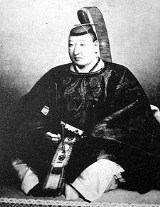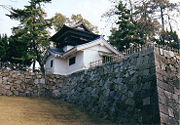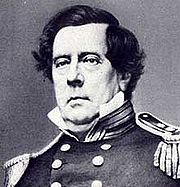
Abe Masahiro
Encyclopedia
was the chief senior councillor (rōjū
) in the Japanese government
at the time of the arrival of Commodore Matthew Perry
. Against the shogun's wishes, and the wishes of many other government officials, he worked to open Japan to the West, signing the Convention of Kanagawa
in 1854, and other unequal treaties
shortly afterwards.
. He was the 6th son of Abe Masakiyo, the 5th lord of Fukuyama
. Upon his father's death in 1826, his elder brother Masayasu became lord of Fukuyama; Abe was moved to the domain's naka-yashiki (middle residence) in Hongō, Edo (modern-day Bunkyō, Tokyo
). However, in 1836, Masayasu adopted his brother as heir. Abe succeeded to family headship upon his brother's retirement in early 1837, and became lord of Fukuyama
, taking the opportunity to make the long journey there.

(master of ceremony) in 1838; in 1840 Abe received the post of jisha bugyō (minister of shrines and temples). He became rōjū
three years later, in 1843, moving his residence to the Abe family's estate at Tatsunokuchi, outside Edo Castle
. He became rōjū shuza (老中首座, presiding senior councillor) in the same year, after Mizuno Tadakuni
lost his standing over the failure of the Tenpo reforms
. Throughout the course the reigns of the 12th and 13th shoguns Ieyoshi
and Iesada
, Abe worked to unify shogunate politics. He supervised the reconstruction of the western enceinte of Edo Castle
in 1852, and was awarded an increase of 10,000 koku
in income for this service. In the meantime, he kept the shogunate abreast of foreign political developments, such as the outbreak of the First Opium War
.
 Commodore Perry's famous episode of gunboat diplomacy
Commodore Perry's famous episode of gunboat diplomacy
occurred in early 1854; Abe was one of the top officials of the shogunate to meet with Perry, and his officers, to negotiate arrangements between their two countries. In March, Abe signed the Convention of Kanagawa, marking the beginnings of the opening of Japan and extending the arm of friendship to the United States
. The treaty allowed for American use of certain Japanese sites as coaling stations, the opening of several ports, and the establishment of a consulate. Abe would then sign similar treaties with Russia, the Netherlands
, and England
very soon afterwards.
All of this raised significant opposition both within the shogunal government, and without, among political factions defined by the slogan sonnō jōi
(尊皇攘夷, "Revere the Emperor, Expel the Barbarians"). Thus, he resigned in October 1855 and was replaced by Hotta Masayoshi
, who sought to undo much of Abe's work, and to close Japan
once more.
, and supported the notion of government selection of talented men, even of low birth, to serve as workers or bureaucrats.
Abe died in 1857, and was succeeded by his nephew, Abe Masanori.
Roju
The ', usually translated as Elder, was one of the highest-ranking government posts in Tokugawa Japan. The term refers either to individual Elders, or to the Council as a whole; under the first two shoguns, there were only two Rōjū...
) in the Japanese government
Tokugawa shogunate
The Tokugawa shogunate, also known as the and the , was a feudal regime of Japan established by Tokugawa Ieyasu and ruled by the shoguns of the Tokugawa family. This period is known as the Edo period and gets its name from the capital city, Edo, which is now called Tokyo, after the name was...
at the time of the arrival of Commodore Matthew Perry
Matthew Perry (naval officer)
Matthew Calbraith Perry was the Commodore of the U.S. Navy and served commanding a number of US naval ships. He served several wars, most notably in the Mexican-American War and the War of 1812. He played a leading role in the opening of Japan to the West with the Convention of Kanagawa in 1854...
. Against the shogun's wishes, and the wishes of many other government officials, he worked to open Japan to the West, signing the Convention of Kanagawa
Convention of Kanagawa
On March 31, 1854, the or was concluded between Commodore Matthew C. Perry of the U.S. Navy and the Tokugawa shogunate.-Treaty of Peace and Amity :...
in 1854, and other unequal treaties
Unequal Treaties
“Unequal treaty” is a term used in specific reference to a number of treaties imposed by Western powers, during the 19th and early 20th centuries, on Qing Dynasty China and late Tokugawa Japan...
shortly afterwards.
Early life
Abe Masahiro was born in his family's residence outside Edo CastleEdo Castle
, also known as , is a flatland castle that was built in 1457 by Ōta Dōkan. It is located in Chiyoda in Tokyo, then known as Edo, Toshima District, Musashi Province. Tokugawa Ieyasu established the Tokugawa shogunate here. It was the residence of the shogun and location of the shogunate, and also...
. He was the 6th son of Abe Masakiyo, the 5th lord of Fukuyama
Fukuyama Domain
The ' was a Japanese domain of the Edo period, located in Bingo and Bitchū provinces.-List of lords:*Mizuno clan, 1619-1698 #Katsunari#Katsutoshi#Katsusada#Katsutane#Katsumine*Tenryō, 1698-1700...
. Upon his father's death in 1826, his elder brother Masayasu became lord of Fukuyama; Abe was moved to the domain's naka-yashiki (middle residence) in Hongō, Edo (modern-day Bunkyō, Tokyo
Bunkyo, Tokyo
is one of the 23 special wards of Tokyo, Japan. Situated in the middle of the ward area, Bunkyō is a residential and educational center. Beginning in the Meiji period, literati like Natsume Sōseki, as well as scholars and politicians have lived there...
). However, in 1836, Masayasu adopted his brother as heir. Abe succeeded to family headship upon his brother's retirement in early 1837, and became lord of Fukuyama
Fukuyama Domain
The ' was a Japanese domain of the Edo period, located in Bingo and Bitchū provinces.-List of lords:*Mizuno clan, 1619-1698 #Katsunari#Katsutoshi#Katsusada#Katsutane#Katsumine*Tenryō, 1698-1700...
, taking the opportunity to make the long journey there.

Career in the Tokugawa Shogunate
Abe was appointed a SoshabanSōshaban
were officials of the Tokugawa shogunate in Edo period Japan. Conventional interpretations have construed this Japanese title as "master of ceremonies."...
(master of ceremony) in 1838; in 1840 Abe received the post of jisha bugyō (minister of shrines and temples). He became rōjū
Roju
The ', usually translated as Elder, was one of the highest-ranking government posts in Tokugawa Japan. The term refers either to individual Elders, or to the Council as a whole; under the first two shoguns, there were only two Rōjū...
three years later, in 1843, moving his residence to the Abe family's estate at Tatsunokuchi, outside Edo Castle
Edo Castle
, also known as , is a flatland castle that was built in 1457 by Ōta Dōkan. It is located in Chiyoda in Tokyo, then known as Edo, Toshima District, Musashi Province. Tokugawa Ieyasu established the Tokugawa shogunate here. It was the residence of the shogun and location of the shogunate, and also...
. He became rōjū shuza (老中首座, presiding senior councillor) in the same year, after Mizuno Tadakuni
Mizuno Tadakuni
was a daimyō during late-Edo period Japan, who later served as chief senior councilor in service to the Tokugawa Shogunate. He is remembered for having instituted the Tenpo Reform.-Biography:...
lost his standing over the failure of the Tenpo reforms
Tenpo reforms
The were an array of economic policies introduced in 1842 by the Tokugawa Shogunate in Japan.These reforms were efforts to resolve perceived problems in military, economic, agricultural, financial and religious systems....
. Throughout the course the reigns of the 12th and 13th shoguns Ieyoshi
Tokugawa Ieyoshi
Tokugawa Ieyoshi was the 12th shogun of the Tokugawa shogunate of Japan.He was the second son of the 11th shogun, Tokugawa Ienari, and appointed Mizuno Tadakuni to conduct the Tenpo reform....
and Iesada
Tokugawa Iesada
Tokugawa Iesada Tokugawa Iesada Tokugawa Iesada (徳川 家定 (May 6, 1824 – August 14, 1858) was the 13th shogun of the Tokugawa shogunate of Japan who held office for only 5 years, from 1853 to 1858. He was physically weak and therefore unfit to be shogun in this period of great challenges...
, Abe worked to unify shogunate politics. He supervised the reconstruction of the western enceinte of Edo Castle
Edo Castle
, also known as , is a flatland castle that was built in 1457 by Ōta Dōkan. It is located in Chiyoda in Tokyo, then known as Edo, Toshima District, Musashi Province. Tokugawa Ieyasu established the Tokugawa shogunate here. It was the residence of the shogun and location of the shogunate, and also...
in 1852, and was awarded an increase of 10,000 koku
Koku
The is a Japanese unit of volume, equal to ten cubic shaku. In this definition, 3.5937 koku equal one cubic metre, i.e. 1 koku is approximately 278.3 litres. The koku was originally defined as a quantity of rice, historically defined as enough rice to feed one person for one year...
in income for this service. In the meantime, he kept the shogunate abreast of foreign political developments, such as the outbreak of the First Opium War
First Opium War
The First Anglo-Chinese War , known popularly as the First Opium War or simply the Opium War, was fought between the United Kingdom and the Qing Dynasty of China over their conflicting viewpoints on diplomatic relations, trade, and the administration of justice...
.

Gunboat diplomacy
In international politics, gunboat diplomacy refers to the pursuit of foreign policy objectives with the aid of conspicuous displays of military power — implying or constituting a direct threat of warfare, should terms not be agreeable to the superior force....
occurred in early 1854; Abe was one of the top officials of the shogunate to meet with Perry, and his officers, to negotiate arrangements between their two countries. In March, Abe signed the Convention of Kanagawa, marking the beginnings of the opening of Japan and extending the arm of friendship to the United States
United States
The United States of America is a federal constitutional republic comprising fifty states and a federal district...
. The treaty allowed for American use of certain Japanese sites as coaling stations, the opening of several ports, and the establishment of a consulate. Abe would then sign similar treaties with Russia, the Netherlands
Kingdom of the Netherlands
The Kingdom of the Netherlands is a sovereign state and constitutional monarchy with territory in Western Europe and in the Caribbean. The four parts of the Kingdom—Aruba, Curaçao, the Netherlands, and Sint Maarten—are referred to as "countries", and participate on a basis of equality...
, and England
United Kingdom of Great Britain and Ireland
The United Kingdom of Great Britain and Ireland was the formal name of the United Kingdom during the period when what is now the Republic of Ireland formed a part of it....
very soon afterwards.
All of this raised significant opposition both within the shogunal government, and without, among political factions defined by the slogan sonnō jōi
Sonno joi
is a Japanese political philosophy and a social movement derived from Neo-Confucianism; it became a political slogan in the 1850s and 1860s in the movement to overthrow the Tokugawa bakufu, during the Bakumatsu period.-Origin:...
(尊皇攘夷, "Revere the Emperor, Expel the Barbarians"). Thus, he resigned in October 1855 and was replaced by Hotta Masayoshi
Hotta Masayoshi
was a Japanese daimyo in the Edo period; and he was a prominent figure in the Tokugawa shogunate.-Rōjū:the Shogun's advisor from 1837 to 1843, and again from 1855 to 1858...
, who sought to undo much of Abe's work, and to close Japan
Sakoku
was the foreign relations policy of Japan under which no foreigner could enter nor could any Japanese leave the country on penalty of death. The policy was enacted by the Tokugawa shogunate under Tokugawa Iemitsu through a number of edicts and policies from 1633–39 and remained in effect until...
once more.
Later Life and Death
Despite his resignation, Abe continued to have significant influence for the rest of his life. He aided in the formation of a modern military, advocated the study of Western sciencesRangaku
Rangaku is a body of knowledge developed by Japan through its contacts with the Dutch enclave of Dejima, which allowed Japan to keep abreast of Western technology and medicine in the period when the country was closed to foreigners, 1641–1853, because of the Tokugawa shogunate’s policy of national...
, and supported the notion of government selection of talented men, even of low birth, to serve as workers or bureaucrats.
Abe died in 1857, and was succeeded by his nephew, Abe Masanori.
Further reading
- Doi Ryōzō 土居良三 (2000). Kaikoku e no fuseki: hyōden, rōjū shuza Abe Masahiro 開国への布石: 評伝・老中首座阿部正弘. Tokyo: Miraisha 未來社.
- Feifer, George (2006). Breaking open Japan: Commodore Perry, Lord Abe, and American imperialism in 1853. New York: Smithsonian Books/Collins.
- Watanabe Shūjirō 渡辺修二郎 (1978). Abe Masahiro jiseki 阿部正弘事蹟. Tokyo: Tokyo Daigaku Shuppankai 東京大學出版會.
- Totman, Conrad. “From Sakoku to Kaikoku, The Transformation of Foreign-Policy Attitudes, 1853-1868.” Monunmenta Nipponica. Vol. 35 No. 1, p. 1-19.
- Totman, Conrad (1980). The Collapse of the Tokugawa Bakufu 1862-1868. Honolulu: University of Hawai'i Press.

